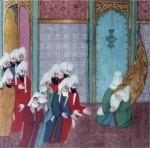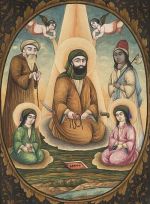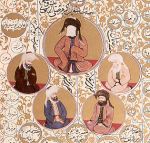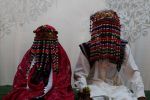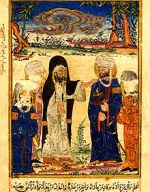Portal: Muhammad's Companions and Contemporaries
Muhammad's contemporaries, companions, and successors play an elevated role in the lore of Islam. It is against many of his contemporaries that Muhammad defined his movement, it is through his companions that his tradition was passed forth, and it is by his immediate successors that his legacy was interpreted and formalized. Excepting those who opposed him, a hadith in Bukhari captures the general manner in which Muhammad's and following generations have been conceived by the Islamic tradition: "Narrated `Abdullah: The Prophet (ﷺ) said, 'The best people are those of my generation, and then those who will come after them (the next generation), and then those who will come after them (i.e. the next generation), and then after them, there will come people whose witness will precede their oaths, and whose oaths will precede their witness.'[1] The earliest generations of Muslims have in the recent past become a topic of renewed interest as a result of the various Salafi movements that have spread across the world and which seek, more than anything else, to restore Islam to the version of it that was practiced by Muhammad's companions and immediate successors.
Overview
The varying levels of reverence and precedential importance accorded to Muhammad, his family, his companions, their contemporaries, and each successive generations is of great importance in the Islamic tradition. The reasoning for this importance is best understood in light of the fact that the Islamic tradition is one centered on the precedence set by individual persons, rather than on the particular arguments for or consequences of any given practice or belief. This is not to say that thinkers in the Islamic tradition did not elaborate and discuss the reasons for and consequences of any given practice or belief (be it religious or legal), but that, at the end of the day, these considerations were always secondary and tertiary to the authority of the individual who first implemented them. As a result, the variety of persons responsible for instituting a practice is overwhelmingly the justification for it, although other considerations may be factored in subsequently. More important than these other considerations, however, will always be the interpretations of the given practice or belief advanced (usually by subsequent generations or groups of persons of lesser authority, although a party may in some cases explain its own reasoning). Broadly speaking, therefore, the first question is in all cases is who said to believe or do this? ('Muhammad' being the best possible answer), the second question is who interpreted this practice or belief? (here again, as always, Muhammad is the best answer, however one will almost always need to look to Muhammad's companions or successors for an explanation), and the third question is what can be said rationally about this practice? (by this point, however, the room for autonomy on the part of the jurist or theologian is usually considerably diminished if not altogether gone). At each level, one hopes for the highest authority available, but available references usually increase in descending order of authority and one will not, of course, expect to find an explanation for the actions of Muhammad's successors from someone who preceded them, such as, say, Muhammad himself.
Male companions
7th century Arabian society was, as can only be expected of any society operating in a harsh environment of scarce resources and perpetual warfare, dominated by men. The most influential of Muhammad's companions on the trajectory of Islam were, it should therefore come as no surprise, men. The four of Muhammad's companions to succeed him were also reported to have been highly influential and near to Muhammad during his own life. It is not clear, through the eyes of a historian, whether the central role of Abu Bakr, Umar, Uthmaan, and Ali - in roughly order - during Muhammad's lifetime is the obvious precedent which enabled them to be chosen as his successors or whether their centrality in the narratives of the seerah (prophetic biographies) and hadith (prophetic narrations) written down long after their own demise was a product of their influence on the historical imagination of devout Muslims posthumous to Muhammad's death. In either case, however, their influence on the trajectory and history of Islam was, and perhaps inextricably remains, immense. It should also be noted that whereas the patriarchal arrangements of early Islamic society hardly deserve indictment, given their historical situation and the fact that they were in a limited sense an improvement upon pre-Islamic gender norms, the same can, perhaps, not be said about the perpetual enshrinement of those patriarchal norms - however much an improvement in 7th century Arabia - as took place in the ideas of Islamic law that finally emerged.
Female companions
The female companions of the prophet Muhammad were, on the whole, far less influential with respect to the early history and trajectory of Islam than his male companions. To the extent that some women were exceptionally important in the narratives that emerged about Muhammad's life and influential in the materially-evidenced historical experience of Islam, they were either blood relatives of Muhammad or his sexual mates (or, in the case of Zaynab, both). Exceptions to these exceptions also existed, such as Muhammad's foster-mother, although these were of still reduced significance. The two most influential women in early Islamic history are, without question, Khadija bint Khuwaylid (Muhammad's first wife) and Aisha bint Abi Bakr (Muhammad's youngest and most favored wife). The former was the first confidant of and in all likelihood a formative influence upon Muhammad when he first proclaimed his prophethood. The latter, after being cause of much controversy and domestic discord during Muhammad's own life (albeit of less direct impact other than that), would become hugely important in the direction Islam took after Muhammad's death when she decided to take a stand against Ali - a move on her part without which Shi'ism, as it is today known, may not have existed.
Opponents
All those who did not side with Muhammad and his movement were its opponents. It is important to distinguish , however, between these 'opponents' of Islam and the necessarily more limited of contemporaries who can fairly be described as having been 'enemies' of Islam (all these, as shall be seen shortly, also being his opponents). As an imperial movement of universal ambition, Islam divided the world's lands and people into two fundamentally different parts: those conquered, conversion or tribute, and those not. While it is true that not all those unconquered persons felt inimical to Islam as such (the Persians, when Muhammad first started preaching in Mecca, for instance, could hardly have cared about Islam had they known of it), they were nonetheless persons Islam ultimately would need to subdue and thus, in a sense, stood in Islam's way. To give a specific example, the Islamic tradition makes it clear that Abu Lahab was inimical towards Muhammad and Islam from the very beginning and actively tried to shut him and his movement down - it is clear, therefore, that he was an enemy, and it is unsurprising that he was condemned as such. It seems, however, that other persons such as Umm Qirfa (an poetess of wide repute) only started mobilizing in any capacity against Muhammad much, much later, when it was clear that Muhammad's warriors were coming for them - it is much harder to think of these persons as having anything more than self-preservation in mind in their showing resistance to Muhammad and, one suspects, they would have been indifferent towards Islam were it not for their fear of being subdued. This group, rather than the likes of Abu Lahab, would appear to be the majority of those who ultimately found themselves at cross-purposes with or under the sword of Muhammad and his followers. While the distinction may be slight and not in all cases clear - since it is not entirely clear what the difference between self-preservation and enmity might be at a very fundamental level - it is nonetheless important.
Others
Those who figured in Muhammad's life who were not either his companions or at some level his opponents were few indeed. The most important of these groups would include those persons who Muhammad knew but who passed away before he proclaimed prophethood, such as his parents, as well as those reported diplomatic acquaintances of his who he never confronted in a military/imperial context, such as al-Najashi, the ruler of Abyssinia. Muhammad's relationships and assessments of this type of person can be described as ambiguous at best and are arguably some of the most historically dubious.
